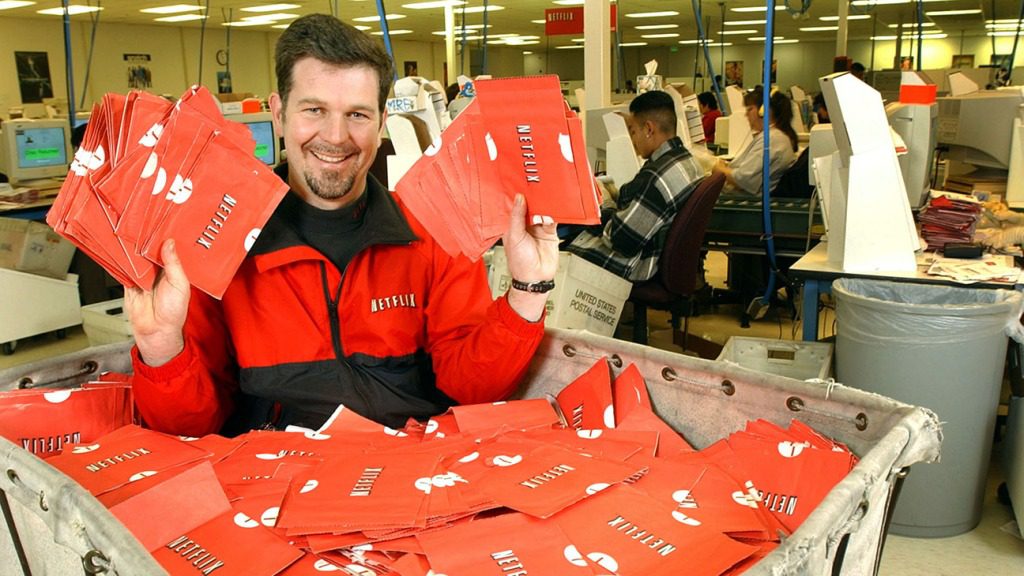Global Courant 2023-04-28 18:45:00
On April 18, Netflix announced that it was “sunsetting” — aka terminating — its material-world DVD rental option. The last picture show in the form of five-inch discs hand-delivered to your door in red envelopes will shut down on September 29, 2023. After 25 years of mail-order interface, “DVDs are done,” Netflix co-founder Marc Randolph declared, adding an unsentimental kiss-off: “Thank you for your service.”
Although it was only inevitable that Netflix would embrace the promise embedded in its name, the announcement struck many as another death rattle from the sickbed of physical media, that resonant term for a record album, film reel, or DVD box set you can actually get your paws on and collect. Increasingly, there is only one way to press play on home entertainment and that is by logging on and streaming (or downloading) a digital file.
Netflix’s disc-toss feels like a decisive pivot point because the trajectory of the company neatly parallels the second stage in the evolution of hands-on, at-home movie watching. The first stage, of course, was television, which busted up Hollywood’s racket in the immediate postwar period. The second stage began with VHS, crested with DVD, and seems now to have come to rest with digital streaming, which is where we all come in.
Introduced in the mid-1970s, VHS (Video Home System) cassette tapes were the first great revolution in home entertainment since the television became essential living room furniture. One way to relate to the new video technology was to seize the means of production (video cameras and blank cassette tapes) and create do-it-yourself productions that documented weddings, bar mitzvahs and more; the other way in was to let the professionals do it and take home a feature film on the new format.
Ironically, the gateway drug was not a commercial film title but a fitness regimen, Jane Fonda’s Workout. In 1982, the well-toned actress did for the purchase of VHS cassettes and players what Milton Berle did for television sets in 1949. Fonda’s tape retailed for $59.95, well worth the price for a 90-minute lesson played daily, but the return on investment for a feature film watched once or twice was less attractive: Blade Runner, Star Trek II: The Wrath of Khan, and An Officer and a Gentleman (all 1982) retailed for $39.95; premium selections like Gone With the Wind (1939) and Pinocchio (1940) sold for a sticker shocking $79.95. Prices of VHS tapes gradually went down — in 1986, Top Gun retailed for $26.95 — but in an age when it was cheaper to take a date to Top Gun than buy the VHS, many consumers opted for temporary custody rather than permanent possession.
Although big outfits like Hollywood Video and countless mom-and-pop shops rushed into the rental market, the emblematic and hegemonic outlet was Blockbuster Video Inc., which seems fated to go down in media history as the village blacksmith shop to Netflix’s automotive garage. Founded in 1985 by Texas oilman David Cook, Blockbuster opened its flagship store in Dallas with an inventory of 8,000 VHS and 2,000 Beta tapes (The loser in the decade-long “format wars,” Betamax was a superior, but short-lived, analog videotape format from Sony.) Blockbuster specialized in rentals, not sales (“Margins for tape sales are pretty lousy,” said Cook), required no membership fees, and charged $1-$2 per rental, depending on the title.
The company took off like a rocket. The business model was simple: high traffic turnover, convenient store locations, a wide selection of movies with clearly marked categories, swift computerized checkouts and after-hours return bin. By 1994, the year Blockbuster was acquired by Viacom, it had vacuumed up 20 percent of the market. By 1997, the slice was 27 percent, three times more than its closest competitor, Hollywood Video.
Members of a certain generation may remember the ritual of a Friday night pilgrimage to Blockbuster to book in the weekend’s entertainment — the aisles packed with parents and teens lunging for the last copy of a hot new release. By 1999, Blockbuster — nicknamed “McVideo” in the trade — operated some 6,500 stores worldwide serving 91 percent of American homes that owned a VHS player, a level of penetration that nearly matched broadcast television.
In 1997, the introduction of the Digital Versatile (not Video) Disc loomed to expand, not upend, the video rental market. Early adopters (including many young men) defected to the disc in droves. Just two years out, 1999 was hailed by the trade press as “the year of the DVD.” The buffs and the techies touted the virtues of the DVD’s higher resolution and capacity for supplementary “extras,” but another quality proved no less transformative: the size of the format, thin and light, was easy to slip into a mail slot.
Enter Netflix. In a recent thread on Twitter, Marc Randolph recalled the salad days of the upstart enterprise, how co-founder Reed Hastings and himself (“two Silicone Valley geeks”) envisioned a “DVD rental by mail idea” built upon a “no-due -dates, no-late fees subscription model” and online orders. “It’s not by any means going to replace the video store,” Randolph told Billboard in 1998, although he was probably already seeing the brick-and-mortar competition in his crosshairs. (The longer version of the origin story is told in Randolph’s The Birth of Netflix and the Amazing Life of an Idea That Will Never Work, published in 2019, a likely blueprint for a future Ben Affleck-Matt Damon film.)
For $4 per title, the customer purchased a seven-day DVD rental that could be sent back in a pre-addressed, pre-paid label. No need to go to a store, no need to make snap selection decisions before another customer grabs your cassette. (Netflix did share one affinity with Blockbuster: it refused to traffic in porn, “an absolute no-no,” noted Randolph.)
Netflix prospered until the dot-com bubble burst in 2000 and the company found itself with cashflow problems. Randolph tells how, desperate for funding, Hastings and he went to Blockbuster to broker a partnership. Unable to constrain himself from kicking the corpse of the late competition, he notes that the Blockbuster execs smirked and passed on the deal.
Around that time, prime shelf space at Blockbuster, heretofore the privileged property of the VHS tape, was being edged aside by DVDs. “I need to get a DVD player,” said every Blockbuster customer, eyeing the shelves.
Blockbuster was slow to pick up on the warning signals. “The company’s favored pitch point — that 70% of US households live within a 10-minute drive of a Blockbuster store — will not mean much when the user/viewer can stay home and make his or her selection,” trade reporter Denis Seguin observed in 2000 in Screen. Not until 2003 did it venture into online rental, by which time Netflix was the undisputed bigfoot. In 2010, Blockbuster filed for bankruptcy. The company’s obituary in The New York Times had a headline worthy of Variety: “Why Bricks and Clicks Don’t Always Mix.”
Now Netflix has nixed the clicks, at least the ones that summoned an agent of the US Postal Service to your door. However, before film buffs and pack rats wax too nostalgic about the end of the DVD delivery service, they might remember how limited the library of selections on Netflix is. Like Blockbuster, which might stock 100 copies of The Blair Witch Project (1999) and not a single silent film, the bulk of the Netflix streaming inventory is drawn from titles that have opened at a mall multiplex in the 21st century. Writer and self-described “videostore vixen” Kate Hagen did the math. “At this moment, Netflix is streaming about 3,800 films — less than half of what the average Blockbuster used to carry.” (Well, not my Blockbuster.) “As for films made before 1990, only 79 titles are currently streaming. If we go to 1980 or earlier, that drops to 36.”
The upshot, as ever, is that the more that film exists only in a digital realm, the more the decisions about availability are in corporate hands, where monetization is the main criterion for access. From this perspective, for the collector of physical media, the Netflix disc-toss may have one archival upside: the upcoming fire sale on used DVDs on eBay.








